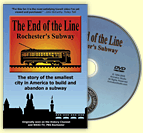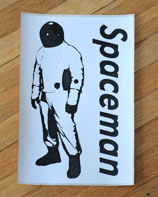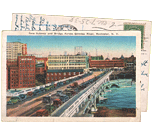![The Garbage Incinerator at High Falls, Rochester. [PHOTO: Robert Cunningham]](https://www.rochestersubway.com/images/photos/rochester-garbage-incinerator-plant-00.jpg)
Last week we looked at some photos of the Beebee Station power plant at High Falls. That post drew some comments about another interesting facility nearby which is sometimes confused with Beebee; the City’s old garbage incinerator plant on Falls Street  .
.
Thanks to a group of intrepid urban explorers—Benjamin Colburn  , Brandon Davis
, Brandon Davis  , Sean Galbraith
, Sean Galbraith  , Andrew Hiltz
, Andrew Hiltz  , and Tom Maszerowski
, and Tom Maszerowski  —we can take a look inside…
—we can take a look inside…
![The Garbage Incinerator at High Falls, Rochester. [PHOTO: Albert R. Stone]](https://www.rochestersubway.com/images/photos/rochester-garbage-incinerator-plant-01.jpg)
The original incinerator plant was built in 1911 by Decarie Incinerator Company of Minneapolis. The photo above shows the older facility which was demolished around 2012. The taller brick building and smoke stack that remain today (shown below) were built in the 1940s.

The plant was decommissioned and taken over by Delco (an automotive parts manufacturing subsidiary of General Motors) in the late 1950s, and eventually abandoned sometime around 1990.
![The Garbage Incinerator at High Falls, Rochester. [PHOTO: Tom Maszerowski]](https://www.rochestersubway.com/images/photos/rochester-garbage-incinerator-plant-03.jpg)
PHOTO: Tom Maszerowski
According to this 1912 issue of Municipal Journal  the incinerator first began operating in February, 1912…
the incinerator first began operating in February, 1912…
This plant is of 60 tons capacity and is representative of the latest and most improved form of incinerator designed by this company. It is intended to handle rubbish only and is equipped with inclined conveyor from receiving floor to sorting room where the various salable rubbish is removed by pickers and deposited in bins the remainder passing by means of the same conveyor to and over the incinerator where it automatically dumps into a hopper and chute to the furnace.
![The Garbage Incinerator at High Falls, Rochester. [PHOTO: Andrew Hiltz]](https://www.rochestersubway.com/images/photos/rochester-garbage-incinerator-plant-04.jpg)
PHOTO: Andrew Hiltz
Between the receiving floor and the incinerator room there is a baling room equipped with a motor driven baling machine in which the paper of various classes will be baled.
![The Garbage Incinerator at High Falls, Rochester. [PHOTO: Sean Galbraith]](https://www.rochestersubway.com/images/photos/rochester-garbage-incinerator-plant-05.jpg)
PHOTO: Sean Galbraith
In connection with the incinerator there is installed a 150 hp water tube boiler through which the combustion gases from the furnace pass and thence to the stack.
![The Garbage Incinerator at High Falls, Rochester. [PHOTO: Tom Maszerowski]](https://www.rochestersubway.com/images/photos/rochester-garbage-incinerator-plant-06.jpg)
PHOTO: Tom Maszerowski
The power for motor driven conveyors and baling machines and for lighting the plant is purchased from a local electric lighting company at 2J4 cents per kilowatt hour and the steam produced has been contracted for by the same company at the rate of 10 cents per 1,000 lbs per hour.
![The Garbage Incinerator at High Falls, Rochester. [PHOTO: Tom Maszerowski]](https://www.rochestersubway.com/images/photos/rochester-garbage-incinerator-plant-07.jpg)
PHOTO: Tom Maszerowski
![The Garbage Incinerator at High Falls, Rochester. [PHOTO: Tom Maszerowski]](https://www.rochestersubway.com/images/photos/rochester-garbage-incinerator-plant-08.jpg)
PHOTO: Tom Maszerowski
![The Garbage Incinerator at High Falls, Rochester. [PHOTO: Andrew Hiltz]](https://www.rochestersubway.com/images/photos/rochester-garbage-incinerator-plant-09.jpg)
PHOTO: Andrew Hiltz
![The Garbage Incinerator at High Falls, Rochester. [PHOTO: Tom Maszerowski]](https://www.rochestersubway.com/images/photos/rochester-garbage-incinerator-plant-10.jpg)
PHOTO: Tom Maszerowski
![The Garbage Incinerator at High Falls, Rochester. [PHOTO: Tom Maszerowski]](https://www.rochestersubway.com/images/photos/rochester-garbage-incinerator-plant-11.jpg)
PHOTO: Tom Maszerowski
In a 1915 survey and appraisal  of City services, an account of the plant’s operations was written in great detail:
of City services, an account of the plant’s operations was written in great detail:
A plant for the burning of the rubbish was built in 1911, and put in operation early in 1912. It included, in addition to the burning or incineration, a provision for the reclamation of the valuable portions of the rubbish.
![The Garbage Incinerator at High Falls, Rochester. [PHOTO: Tom Maszerowski]](https://www.rochestersubway.com/images/photos/rochester-garbage-incinerator-plant-12.jpg)
PHOTO: Tom Maszerowski
The conditions which must now be met by a rubbish plant in Rochester are as follows: It must handle all the rubbish from a population estimated to be about 240,000 consisting of paper, wood, leather, rags, old clothing, bedding, shoes, bottles, broken glass, empty cans, metal scrap, and other discarded trash which is not placed in the ash or garbage can. This material is collected daily from the business portion of the city throughout the year, and once per week from the residential section.
![The Garbage Incinerator at High Falls, Rochester. [PHOTO: Andrew Hiltz]](https://www.rochestersubway.com/images/photos/rochester-garbage-incinerator-plant-13.jpg)
PHOTO: Andrew Hiltz
In addition to the above mentioned material a large quantity of rubbish classed as “trade waste” also finds its way to the plant. This material may be defined as the rubbish from the manufacturing plants, power houses, business buildings, large stores, warehouses, hotels, restaurants, etc., or in general, the rubbish from any place where it is produced in the regular course of a business conducted for profit. In 1914 the following amounts and classes of rubbish were handled by the plant:
Total weight received 10,392 tons
Material per 1,000 persons 43.3 tons
Total valuable portions reclaimed 3,146 tons
Percent reclaimed 30.3%
Material reclaimed per 1,000 persons 13.1 tons
![The Garbage Incinerator at High Falls, Rochester. [PHOTO: Tom Maszerowski]](https://www.rochestersubway.com/images/photos/rochester-garbage-incinerator-plant-14.jpg)
PHOTO: Tom Maszerowski
The plant had three sections with three distinct functions: unloading/storage, sorting/baling, and incineration.
![The Garbage Incinerator at High Falls, Rochester. [PHOTO: Andrew Hiltz]](https://www.rochestersubway.com/images/photos/rochester-garbage-incinerator-plant-15.jpg)
PHOTO: Andrew Hiltz
In the sorting & baling section trash was separated into items that could be reclaimed and sold, and rubbish to be burned. The 1915 report lists several materials that could be reclaimed including brass, copper, lead, zinc, iron, tin cans, pewter, aluminum, and glass.
![The Garbage Incinerator at High Falls, Rochester. [PHOTO: Andrew Hiltz]](https://www.rochestersubway.com/images/photos/rochester-garbage-incinerator-plant-16.jpg)
PHOTO: Andrew Hiltz
Formerly bottles were separated and sold, but now they are broken and sold as broken glass. Shoes also were picked out, but there being no market for them, this is no longer done. The larger pieces of junk which are not valuable are thrown into a bin and later dropped into a wagon and hauled to a dumping place. The tin cans are the last thing picked out before the material leaves the sorting room. They are thrown on the supplementary conveyor and conveyed to the bin outside the building where they are stored until time for shipment.
![The Garbage Incinerator at High Falls, Rochester. [PHOTO: Andrew Hiltz]](https://www.rochestersubway.com/images/photos/rochester-garbage-incinerator-plant-17.jpg)
PHOTO: Andrew Hiltz
The present method of shipping the cans loose in box cars is expensive both as to time in loading and space in the car. It has been suggested that they be baled but objection was raised to pressing the cans flat. It was claimed that the company which buys them cannot remove the tin. Further study may develop the possibility of partially flattening and baling by use of an automatic jaw press or rolls proposed by one of the officers. It is recommended that this matter be taken up with the purchaser and some better way of handling the cans devised.
![The Garbage Incinerator at High Falls, Rochester. [PHOTO: Andrew Hiltz]](https://www.rochestersubway.com/images/photos/rochester-garbage-incinerator-plant-18.jpg)
PHOTO: Andrew Hiltz
The combustible rubbish which is not reclaimed passes out of
the section on the conveyor to the incineration section where it is burned.
![The Garbage Incinerator at High Falls, Rochester. [PHOTO: Andrew Hiltz]](https://www.rochestersubway.com/images/photos/rochester-garbage-incinerator-plant-19.jpg)
PHOTO: Andrew Hiltz
The Incinerator section of the plant contains an incinerator furnace, boilers, and accessories in which, or by which, the nonvaluable combustible portions of the waste are burned, and the heat therefrom utilized in the generation of steam, which is used in the operation of the plant or sold to the Rochester Railway and Light Company. The conveyor from the sorting room rises on a steep incline to a point in the middle of the incinerator room some fifteen feet or more above the top of the furnace where it ends and the material drops into a chute which carries it to an opening at the top of the furnace where it is supposed to slide through automatic doors into the basket grate of the furnace proper. The hot gases generate steam both in the incinerator and in two boilers through which they pass on the way to the stack.
![The Garbage Incinerator at High Falls, Rochester. [PHOTO: Andrew Hiltz]](https://www.rochestersubway.com/images/photos/rochester-garbage-incinerator-plant-20.jpg)
PHOTO: Andrew Hiltz
![The Garbage Incinerator at High Falls, Rochester. [PHOTO: Tom Maszerowski]](https://www.rochestersubway.com/images/photos/rochester-garbage-incinerator-plant-21.jpg)
PHOTO: Tom Maszerowski
![The Garbage Incinerator at High Falls, Rochester. [PHOTO: Brandon Davis]](https://www.rochestersubway.com/images/photos/rochester-garbage-incinerator-plant-22.jpg)
PHOTO: Brandon Davis
The survey went on to report on the benefits of the plant:
The physical results from the installation and operation of the rubbish plant have been the practical elimination of the paper and a great deal of the other rubbish from the dump more sanitary disposal thereof; the reclamation of large quantities of valuable material — as much as 3 per cent, of the total handled; land an improvement in the appearance of the city through the elimination of the unsightly portions of the refuse from the dumps.
![The Garbage Incinerator at High Falls, Rochester. [PHOTO: Andrew Hiltz]](https://www.rochestersubway.com/images/photos/rochester-garbage-incinerator-plant-23.jpg)
PHOTO: Andrew Hiltz
![The Garbage Incinerator at High Falls, Rochester. [PHOTO: Benjamin Colburn]](https://www.rochestersubway.com/images/photos/rochester-garbage-incinerator-plant-24.jpg)
PHOTO: Benjamin Colburn
It is to be noted that the amount of material delivered to the plant has increased over 20 per cent, in 1914 over what it was in 1913, and that the percentage reclaimed has increased 36 per cent. This is probably due to the more careful and thorough separation of the rubbish from the ashes, through the increased attention given by the field collection force, and to the more thorough picking and sorting at the refuse plant, all of which indicates an increase in efficiency.
![The Garbage Incinerator at High Falls, Rochester. [PHOTO: Andrew Hiltz]](https://www.rochestersubway.com/images/photos/rochester-garbage-incinerator-plant-25.jpg)
PHOTO: Andrew Hiltz
![The Garbage Incinerator at High Falls, Rochester. [PHOTO: Andrew Hiltz]](https://www.rochestersubway.com/images/photos/rochester-garbage-incinerator-plant-26.jpg)
PHOTO: Andrew Hiltz
![The Garbage Incinerator at High Falls, Rochester. [PHOTO: Sean Galbraith]](https://www.rochestersubway.com/images/photos/rochester-garbage-incinerator-plant-27.jpg)
PHOTO: Sean Galbraith
The survey also pointed to certain operations which should be improved:
The furnace room results leave much to be desired in several ways. First, the material does not feed into the furnace automatically, as the design originally intended it should. This necessitates the employment of a man in the top of the room where it is especially hot, dusty and smoky. The conditions are so bad in the summer time that few men are able to stand the work for long periods at a time.
![The Garbage Incinerator at High Falls, Rochester. [PHOTO: Andrew Hiltz]](https://www.rochestersubway.com/images/photos/rochester-garbage-incinerator-plant-28.jpg)
PHOTO: Andrew Hiltz
Second, the material is not completely burned, and it is possible for material to be raked out without having passed through the fire for a long enough period to sterilize it.
![The Garbage Incinerator at High Falls, Rochester. [PHOTO: Sean Galbraith]](https://www.rochestersubway.com/images/photos/rochester-garbage-incinerator-plant-29.jpg)
PHOTO: Sean Galbraith
Third, the stoking and removal of partly burned material from the grates to wheelbarrows brings a large amount of dirt on to the floor, and brings smoke into the room.
![The Garbage Incinerator at High Falls, Rochester. [PHOTO: Flickr, chammoudeh]](https://www.rochestersubway.com/images/photos/rochester-garbage-incinerator-plant-30.jpg)
PHOTO: Flickr, chammoudeh
Fourth, the nuisance of a burning dump is not eliminated, although it has been reduced very greatly.
![The Garbage Incinerator at High Falls, Rochester. [PHOTO: Brandon Davis]](https://www.rochestersubway.com/images/photos/rochester-garbage-incinerator-plant-31.jpg)
PHOTO: Brandon Davis
Fifth, the apparent low temperature of combustion, and the lack of complete combustion, make it possible for odors to pass through the furnace without being eliminated, although this trouble will be but seldom experienced in such a plant.
![The Garbage Incinerator at High Falls, Rochester. [PHOTO: Andrew Hiltz]](https://www.rochestersubway.com/images/photos/rochester-garbage-incinerator-plant-32.jpg)
PHOTO: Andrew Hiltz
Operational issues aside, the same report noted that the plant more than paid for itself and recommended adding additional furnace units.
Related Video:
Many thanks to Benjamin Colburn  and Andrew Hiltz
and Andrew Hiltz  for helping to pull this article together.
for helping to pull this article together.
Tags: abandoned, abandoned places, Andrew Hiltz, Benjamin Colburn, Brandon Davis, Falls Street, garbage, garbage incinerator, Genesee River, Genesee River Gorge, High Falls, Rochester, Rochester NY, Sean Galbraith, smokestacks, Tom Maszerowski, trash, trash incinerator, urban exploration, urban explorers, waste disposal
This entry was posted
on Monday, March 3rd, 2014 at 8:05 am and is filed under Reader Submitted Stories, Rochester History, Rochester Images, Transit + Infrastructure, Urban Exploration.
You can follow any responses to this entry through the RSS 2.0 feed.
You can skip to the end and leave a response. Pinging is currently not allowed.

![The Garbage Incinerator at High Falls, Rochester. [PHOTO: Robert Cunningham]](https://www.rochestersubway.com/images/photos/rochester-garbage-incinerator-plant-00.jpg)
![]() .
.![]() , Brandon Davis
, Brandon Davis ![]() , Sean Galbraith
, Sean Galbraith ![]() , Andrew Hiltz
, Andrew Hiltz ![]() , and Tom Maszerowski
, and Tom Maszerowski ![]() —we can take a look inside…
—we can take a look inside…![The Garbage Incinerator at High Falls, Rochester. [PHOTO: Albert R. Stone]](https://www.rochestersubway.com/images/photos/rochester-garbage-incinerator-plant-01.jpg)

![]() the incinerator first began operating in February, 1912…
the incinerator first began operating in February, 1912…![]() of City services, an account of the plant’s operations was written in great detail:
of City services, an account of the plant’s operations was written in great detail:![]() and Andrew Hiltz
and Andrew Hiltz ![]() for helping to pull this article together.
for helping to pull this article together.![]()


























![The Garbage Incinerator at High Falls, Rochester. [PHOTO: Tom Maszerowski]](https://www.rochestersubway.com/images/photos/rochester-garbage-incinerator-plant-03.jpg)
![The Garbage Incinerator at High Falls, Rochester. [PHOTO: Andrew Hiltz]](https://www.rochestersubway.com/images/photos/rochester-garbage-incinerator-plant-04.jpg)
![The Garbage Incinerator at High Falls, Rochester. [PHOTO: Sean Galbraith]](https://www.rochestersubway.com/images/photos/rochester-garbage-incinerator-plant-05.jpg)
![The Garbage Incinerator at High Falls, Rochester. [PHOTO: Tom Maszerowski]](https://www.rochestersubway.com/images/photos/rochester-garbage-incinerator-plant-06.jpg)
![The Garbage Incinerator at High Falls, Rochester. [PHOTO: Tom Maszerowski]](https://www.rochestersubway.com/images/photos/rochester-garbage-incinerator-plant-07.jpg)
![The Garbage Incinerator at High Falls, Rochester. [PHOTO: Tom Maszerowski]](https://www.rochestersubway.com/images/photos/rochester-garbage-incinerator-plant-08.jpg)
![The Garbage Incinerator at High Falls, Rochester. [PHOTO: Andrew Hiltz]](https://www.rochestersubway.com/images/photos/rochester-garbage-incinerator-plant-09.jpg)
![The Garbage Incinerator at High Falls, Rochester. [PHOTO: Tom Maszerowski]](https://www.rochestersubway.com/images/photos/rochester-garbage-incinerator-plant-10.jpg)
![The Garbage Incinerator at High Falls, Rochester. [PHOTO: Tom Maszerowski]](https://www.rochestersubway.com/images/photos/rochester-garbage-incinerator-plant-11.jpg)
![The Garbage Incinerator at High Falls, Rochester. [PHOTO: Tom Maszerowski]](https://www.rochestersubway.com/images/photos/rochester-garbage-incinerator-plant-12.jpg)
![The Garbage Incinerator at High Falls, Rochester. [PHOTO: Andrew Hiltz]](https://www.rochestersubway.com/images/photos/rochester-garbage-incinerator-plant-13.jpg)
![The Garbage Incinerator at High Falls, Rochester. [PHOTO: Tom Maszerowski]](https://www.rochestersubway.com/images/photos/rochester-garbage-incinerator-plant-14.jpg)
![The Garbage Incinerator at High Falls, Rochester. [PHOTO: Andrew Hiltz]](https://www.rochestersubway.com/images/photos/rochester-garbage-incinerator-plant-15.jpg)
![The Garbage Incinerator at High Falls, Rochester. [PHOTO: Andrew Hiltz]](https://www.rochestersubway.com/images/photos/rochester-garbage-incinerator-plant-16.jpg)
![The Garbage Incinerator at High Falls, Rochester. [PHOTO: Andrew Hiltz]](https://www.rochestersubway.com/images/photos/rochester-garbage-incinerator-plant-17.jpg)
![The Garbage Incinerator at High Falls, Rochester. [PHOTO: Andrew Hiltz]](https://www.rochestersubway.com/images/photos/rochester-garbage-incinerator-plant-18.jpg)
![The Garbage Incinerator at High Falls, Rochester. [PHOTO: Andrew Hiltz]](https://www.rochestersubway.com/images/photos/rochester-garbage-incinerator-plant-19.jpg)
![The Garbage Incinerator at High Falls, Rochester. [PHOTO: Andrew Hiltz]](https://www.rochestersubway.com/images/photos/rochester-garbage-incinerator-plant-20.jpg)
![The Garbage Incinerator at High Falls, Rochester. [PHOTO: Tom Maszerowski]](https://www.rochestersubway.com/images/photos/rochester-garbage-incinerator-plant-21.jpg)
![The Garbage Incinerator at High Falls, Rochester. [PHOTO: Brandon Davis]](https://www.rochestersubway.com/images/photos/rochester-garbage-incinerator-plant-22.jpg)
![The Garbage Incinerator at High Falls, Rochester. [PHOTO: Andrew Hiltz]](https://www.rochestersubway.com/images/photos/rochester-garbage-incinerator-plant-23.jpg)
![The Garbage Incinerator at High Falls, Rochester. [PHOTO: Benjamin Colburn]](https://www.rochestersubway.com/images/photos/rochester-garbage-incinerator-plant-24.jpg)
![The Garbage Incinerator at High Falls, Rochester. [PHOTO: Andrew Hiltz]](https://www.rochestersubway.com/images/photos/rochester-garbage-incinerator-plant-25.jpg)
![The Garbage Incinerator at High Falls, Rochester. [PHOTO: Andrew Hiltz]](https://www.rochestersubway.com/images/photos/rochester-garbage-incinerator-plant-26.jpg)
![The Garbage Incinerator at High Falls, Rochester. [PHOTO: Sean Galbraith]](https://www.rochestersubway.com/images/photos/rochester-garbage-incinerator-plant-27.jpg)
![The Garbage Incinerator at High Falls, Rochester. [PHOTO: Andrew Hiltz]](https://www.rochestersubway.com/images/photos/rochester-garbage-incinerator-plant-28.jpg)
![The Garbage Incinerator at High Falls, Rochester. [PHOTO: Sean Galbraith]](https://www.rochestersubway.com/images/photos/rochester-garbage-incinerator-plant-29.jpg)
![The Garbage Incinerator at High Falls, Rochester. [PHOTO: Flickr, chammoudeh]](https://www.rochestersubway.com/images/photos/rochester-garbage-incinerator-plant-30.jpg)
![The Garbage Incinerator at High Falls, Rochester. [PHOTO: Brandon Davis]](https://www.rochestersubway.com/images/photos/rochester-garbage-incinerator-plant-31.jpg)
![The Garbage Incinerator at High Falls, Rochester. [PHOTO: Andrew Hiltz]](https://www.rochestersubway.com/images/photos/rochester-garbage-incinerator-plant-32.jpg)












So, they recycled (reclaimed) and resold 30% of the total waste, do we recycle that much today?